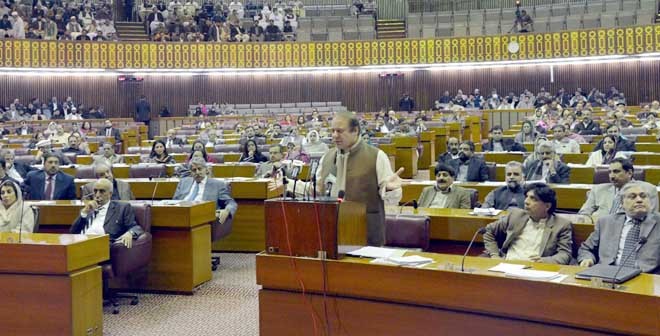

Globally, Pakistan is the most affected country by terrorism, after Iraq. However, if the severity of terrorist incidents is any indication, then Pakistan even surpasses Iraq, reveals the National Internal Security Policy (NISP) document. Interior Minister Chaudhry Nisar Ali Khan tabled the document on the floor of the National Assembly on February 26, 2014, after its approval by the federal cabinet.
Statistically speaking, some 13,897 incidents of terror that the people of Pakistan had to brave from 2001 to 2013 is only marginally less than Iraq. Most of these incidents -- 13,198 to be specific -- have taken place after 2007 while the country witnessed 523 terrorist acts from 2001 to 2006. Last year alone, there were 1,361 incidents of terrorism.
From 2001 to 2006, the country bore the brunt of 15 suicide attacks, but their number increased to 358 from 2007 to 2013. A trajectory of these incidents shows that after Marriot Hotel bombing and Lal Masjid episode in Islamabad, suicide attacks in Pakistan increased alarmingly. Rather, this figure represents the highest number of suicide attacks in any country in the world. Another lethal trend is use of improvised explosive devices against law enforcement agencies that has emerged as a "weapon of choice" of terrorists.
The 94-page NISP document notes that the widespread spectrum of internal threats poses a critical impediment to the economic stability, sustainable development and social harmony, resulting in alarming increase in crime and security threats to the people. It declares "the recent surge in sectarianism" to be "alarming," in particular. Trained in spreading fear through propaganda, the terrorists run campaigns designed and implemented through various channels of communication, including videos, brochures and social media.
A long overdue and much-awaited attempt to rectify the threat of militancy and extremism, the internal security policy draft document has been praised for its candid analysis of the situation. In the new security policy, the government has set some tough and bold targets for itself: It intends to integrate mosques and Madaris to the national education system in one year, undertake legal reforms, construct a national narrative against extremist mindset in six months, improve intelligence-sharing and strengthen coordination between Inter-Services Intelligence and civilian agencies.
When the government decided to register Madaris last year, some 22,052 opted for registration till September 2013. However, thousands other decided not to get them registered with the government. Cognisant of their critical role for a pluralistic society, the NISP envisions the incorporation of Madaris in the mainstream educational framework within one year. This is, indeed, a challenging job.
Attempting to trace non-traditional threats of violent extremism, sectarianism, terrorism and militancy, in part, to Madrassah-based education, the new security policy also refers to the foreign funding of the Madaris, underlying the need for Madrassah reforms. Madrassah reforms were attempted in the past as well, when the then President Pervez Musharraf launched, with much fanfare, a $100 million project with the objective of bringing them at par with the regular school system. Though he had an alliance with the Muttahida Majlis-i-Amal, a conglomerate of religious parties, Musharraf could not bring various sects on one platform to introduce modern subjects to the Madaris.
Identifying a problem is one thing and being able to fix it is quite another. Even after identifying problems, it is easier to develop consensus for setting goals, but quite difficult to develop consensus for achieving those goals. We all want an end to the militancy and peace in the country, but how to achieve that remains a contentious and difficult proposition in our country where people consider the Fiqah that they practice to be the only right one.
After Independence, for about a decade, Islamiat or religious studies could not be introduced in the school curricula in Pakistan because the Sunni and Shia religious scholars could not develop consensus on a common course of studies. Finally, the authorities had to concede to the demand of some clerics and introduce separate syllabus for the Sunni and Shia students. With separate courses of religious studies, the then authorities had unwittingly laid the foundation for the first divide in the society.
But, throughout the years, the authorities neglected the Madaris. It did not care at all to what was taught in the Madaris, who got enrolled in the Madaris and also the pathetic conditions that the students had to endure in those seminaries. Most of the seminary students come from poor families living in the poverty-stricken, under-developed and backward regions of the country. In those areas, due to poverty many parents are impelled to send their children to seminaries in far way towns for pursuing religious studies.
In these seminaries, the students, who are mostly of raw age, receive education under deplorable conditions. It has been observed that small children who are removed from their families at raw age, for one reason or the other, often become violent in their adult life. Some of them develop a feeling of hatred for the current socio-economic system prevalent in the country and become easy targets for brain-washing and exploitation by the vested interests.
In fact, in Pakistan the students have been receiving education in at least four different systems of education -- the Madaris, the public sector vernacular schools, the public sector English medium schools and the private sector English medium schools affiliated to foreign universities, etc. Due to these varying systems of education and courses of studies, the education sector had been churning out youth with different thinking, mindsets and concepts of life.
In a society as fractured as Pakistan, notably on religious grounds, the authorities will, therefore, have to pull off some miracle to develop the required national narrative while continuing to allow studies in four different systems of education. How we fare in this exercise will be seen when the members start debate on the NISP document and approve it or when we try to implement it through the provincial governments!